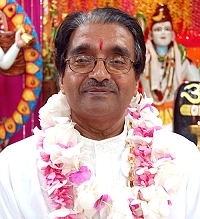From a satsang with Paramacharya of SWAHA, Pt. Hardeo Persad
Pooja is the act of showing reverence or worship to God through the use of invocations, mantras, bhajans and rituals. It can be either physical (upaansu) or mental (maansic). The first type involves making actual physical offerings upon the baydi (altar) or murti of the deity. Mental pooja, however, is performed through visualizations, where one makes offerings mentally to the image of the deity. For instance, if for some reason a person is not able to make physical offerings upon the lingam on Shiv Raatri, that devotee can simply visualize offering jal, milk and so forth. Due to the fact that the devotee, in the performance of maansic pooja, is focusing inward, and contemplating upon the Lord, such worship is actually effective.
Spiritual evolution
Sanaatan Dharma teaches us that the two main syllables in the word ‘pooja’, ‘pa’ and ‘ja’ have tremendous significance. The syllable ‘pa’ stands for ‘paapa naashana’, the purification or removal of accumulated sins and sinful habits. The second syllable ‘ja’ stands for ‘janma viccheda’, freedom from the endless cycle of birth and death (moksha or liberation). Thus, pooja, by helping us to exhaust our accumulated sins, brings about a spiritual evolution that will enable us to reach closer to that eventual goal of moksha.
Our unrefined, mortal intellects are incapable of conceiving God in all His infinite glory. Pooja is a means of bringing the Divine Father or Divine Mother within the realm of our senses. An essential part of pooja for the devotee is making a spiritual connection with a deity. Most often this contact is facilitated through an object or image, which is representative of the form or characteristics of the Divine. By focusing our wandering senses upon an image of the deity, worship will become more meaningful and much simpler.
One thing we should always remember is that God is merciful. He will always forgive the shortcomings of His devotees – once they are not committed intentionally or are unavoidable. Therefore, one must never lament one’s perceived failures in the performance of a pooja or other religious ritual. We should always engage in worship that is directed towards God with an attitude of absolute surrender, with firm faith, love and devotion to the Divine.
A Bridge to the Divine
On the physical plane, the mantras chanted during the pooja create an atmosphere of sacred feelings or vibrations in the house and sanctify the home and immediate surroundings, as well as in the minds of all those present. Pooja establishes a bridge between the devotee and Divine. It facilitates the flow of energy in the form of our love and devotion. This energy not only sanctifies the self but also revitalizes the body’s resources. The actual performance of pooja along with the preparation for pooja has the effect of disciplining the mind of the devotee, ensuring that the individual is ready to welcome the Lord into one’s heart. Pooja involves the symbolic offering of our lives and activities to God. Importantly, at the end of it comes the blessing in the form of the prasaad and panchaamrit, which is sweet in nature and infused with the energy of the Lord.
It is important that we re-commit ourselves to our dharma and re-affirm our faith in the Divine as we continually seek to develop spiritually. This can be more easily accomplished if we make maximum use of the opportunities that present themselves for us to engage meaningfully in forms of worship such as pooja.



